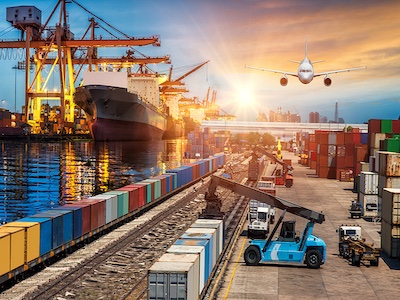Potential Havoc in the Logistics World
There is a potential for chaos in the logistics world with simultaneous strikes from Canada’s rail workers and the U.S. East Coast and Gulf Coast longshoremen. It is gaining in likelihood each day as negotiations are not progressing.
Negotiations between the International Longshoremen’s Association (ILA) and the U.S. Maritime Alliance (USMX) have been tense. The union has been pushing back on the automation of the ports while looking for wage increases that outpace their West Coast counterparts. In today’s supply chain, that would be a recipe for disaster as China’s ports already outperform the U.S. by a WIDE margin with automation and advanced technologies.
In Canada, CN and Canadian Pacific Kansas City (CPKC) have been locked in a standoff with Teamsters Canada Rail Conference (TCRC) for several months. In fact, the railways have stopped shipping hazardous chemicals with an August 22nd deadline to reach an agreement. It is expected that a rail strike will affect agriculture and automotive industries significantly, but it will be felt throughout the region.
Regulations Overwhelm Businesses
California businesses are overwhelmed with regulations that are largely not feasible. As a former Executive of a mid-market manufacturer, I learned to provide aggressive yet realistic goals to engage employees while meeting private equity business objectives. Of course, you want folks to stretch; however, if you provide a completely unrealistic goal (without the talent, tools, and resources required to meet it), the goal becomes completely demotivating. The manufacturing and logistics industries in California have invested millions and billions of dollars collectively to achieve zero emission goals, and they have made HUGE progress. In fact, our logistics and oil industries are far cleaner than anywhere in the world. However, the technology and/or capabilities simply don’t exist to achieve most of the regulations coming down the pike. And businesses are losing the ability to be cost competitive.
There are countless goods movement regulations that fall into this category. Listen to our speech, Geopolitical & Regulatory Issues – the Path Forward in Supply Chain & Logistics to learn about the details. With that said, a recent ruling that is overwhelming logistics firms is the indirect source rule.
The state passed an indirect source rule for warehouses and recently for rail with talk of ports as the next topic for discussion. The best explanation I’ve heard to explain what this means is to think of yourself as the owner of an In-N-Out. You would be responsible for the emissions of all the customers visiting your store. If you have ever driven by an In-N-Out, you know they would have to close down immediately if this rule applied as lines of cars wrap around parking lots. Similarly, warehouses by definition receive, store, and ship goods; thus, being responsible for the emissions of their visitors is prohibitive. There is more to the rules and ways to invest, pay fines etc. However, the bottom line is that it is costly to do business. According to our recent special report, FutureScape: Crafting Tomorrow’s Supply Chain Today, there are shifts to Phoenix, Las Vegas, and Salt Lake City to be close to California consumers for rapid delivery while making sense economically.
Equally concerning, because of the regulations, California has gone from having 30 oil refineries serving the region to 9. Thus, to supply oil to power the region, oil is sent from foreign countries such as Venezuela. The oil is cleaner and lighter if produced in the U.S., and so that is at cross purposes to the environmental objective. With that said, with the tanker at berth regulation, there is no way to meet the regulation because the ships carrying foreign oil cannot electrify. Unfortunately, the only solution is to reduce the number of tankers, thereby limiting supply, and supply will not meet demand.
The Bottom Line: Supply Chain Disruptions are the New Norm
We have published a series of articles related to this topic, citing examples and encouraging executives to look forward. For example, Boeing’s quality issues, the CrowdStrike outage, impacts from the war in the Middle East, and other supply chain chokepoints throughout the world have spurred on recent disruptions. Suffice it to say, we must learn to thrive amidst the chaos.
How to Thrive Amidst the Chaos
Forward-looking companies will be crafting tomorrow’s supply chain today. As discussed in our special report, there are several strategies to successfully navigate a volatile, uncertain, complex, and ambiguous (VUCA) landscape. We review strategies for navigating a technological revolution, transforming talent and workforce planning, creating resilient and adaptive supply chains in our recent article summarizing the report.
We discuss supply chain and inventory optimization techniques as well as advanced technologies that are cornerstone to success. In addition, we describe the critical importance of rolling out a SIOP (Sales Inventory Operations Planning) process to stay ahead of changing conditions to ensure customer value and profitable growth. To learn more about how to rollout a SIOP process, refer to our book, SIOP (Sales Inventory Operations Planning): Creating Predictable Revenue and EBITDA Growth.
In the next few years, we believe the winners will separate from the losers in greater numbers than ever before in history. If you are not forward-thinking, innovative and crafting tomorrow’s supply chain today, you will slowly decline or get absorbed by a stronger company. On the other hand, if you are prepared for whatever disruption comes your way, provide superior value to your customers and roll out the appropriate upgrades to support profitable growth, you will have more business than imaginable as your competition struggles.
Do you want to plan for success or fail by default?
If you are interested in reading more on this topic:
Right-Size Inventory to Thrive During Inflationary & Recessionary Times



